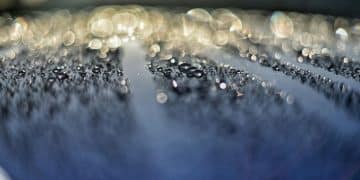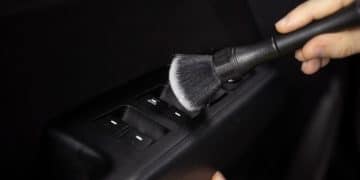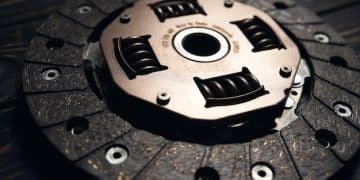Rust Prevention: Protect Your Car from Corrosion
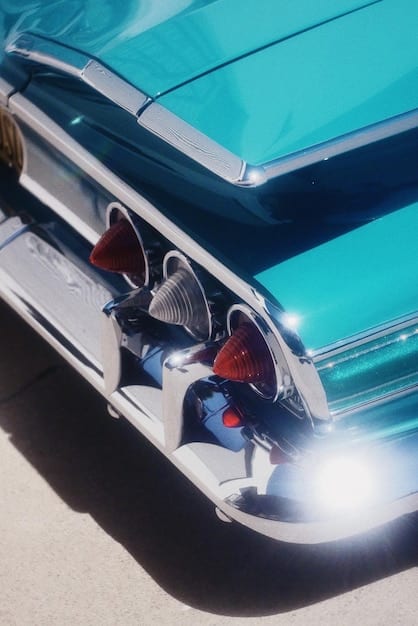
Rust prevention is crucial for maintaining your car’s longevity; effectively protecting your vehicle from rust and corrosion involves regular cleaning, applying protective coatings, and addressing minor rust spots promptly.
Is rust slowly eating away at your beloved car? Rust prevention: How to protect your car from rust and corrosion isn’t just about aesthetics; it’s about preserving your vehicle’s structural integrity and value. Let’s dive into how you can keep rust at bay and your car looking its best.
Understanding the Enemy: What Causes Rust?
Rust is the bane of any car owner’s existence. Before we can effectively combat it, it’s essential to understand what causes it. Knowing the root causes will help you tailor your rust prevention strategies.
The Science Behind Rust
Rust, scientifically known as iron oxide, forms when iron or an iron alloy (like steel) is exposed to oxygen and moisture. This electrochemical process leads to the oxidation of iron, resulting in the reddish-brown, flaky substance we know as rust. Salt accelerates this process, making cars in regions with salted roads particularly vulnerable.
Common Culprits: Where Rust Breeds
Several factors contribute to rust formation. Road salt, moisture, scratches, and even the car’s design can play a role. Here’s a rundown of common culprits:
- Road Salt: Salt used to de-ice roads is highly corrosive, accelerating rust on unprotected metal surfaces.
- Moisture: Rain, snow, and humidity provide the necessary environment for rust to form.
- Scratches and Chips: These expose the bare metal underneath, making it susceptible to oxidation.
- Poor Drainage: Areas where water accumulates, like rocker panels and wheel wells, are prime spots for rust.
Understanding these factors is the first step in developing an effective rust prevention strategy. By knowing where and why rust occurs, you can take targeted actions to safeguard your vehicle.
In summary, rust is a chemical reaction accelerated by environmental factors. Tackling these factors head-on is key to preserving your car’s condition.
The Foundation: Washing and Cleaning Your Car
Washing and cleaning your car regularly isn’t just about keeping it looking shiny; it’s an essential part of rust prevention. Removing dirt, salt, and other contaminants can significantly reduce the risk of corrosion.
Best Practices for Car Washing
Effective car washing goes beyond a quick rinse. Here are some best practices to keep in mind:
- Frequency: Aim to wash your car at least every two weeks, and more frequently during winter when road salt is prevalent.
- Products: Use a car-specific soap, as household detergents can be harsh and strip away protective wax.
- Technique: Wash from top to bottom, using a microfiber wash mitt to avoid scratching the paint. Rinse thoroughly to remove all soap residue.
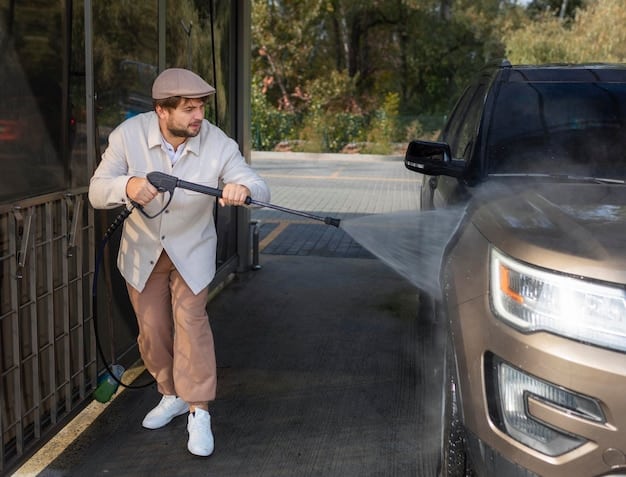
Targeting Trouble Spots
Certain areas of your car are more prone to rust and require extra attention during washing:
- Undercarriage: Use a pressure washer or a hose with a strong nozzle to blast away accumulated salt and grime.
- Wheel Wells: These areas collect a lot of dirt and moisture. Ensure they are thoroughly rinsed.
- Rocker Panels: These are often overlooked but are highly susceptible to rust due to their proximity to the road.
Paying attention to these trouble spots can make a significant difference in rust prevention. Keep them clean, and you’ll greatly reduce the chances of rust formation.
Proper washing and cleaning create a clean slate, allowing other rust prevention measures to be more effective. It’s a simple but crucial step.
Protective Barriers: Waxing and Sealants
After cleaning your car, applying protective barriers like wax or sealant is the next line of defense against rust. These products create a shield that prevents moisture and contaminants from reaching the metal.
The Benefits of Waxing
Waxing provides a temporary protective layer that enhances your car’s shine while guarding against environmental damage. Here’s why waxing is important:
- Protection: Wax creates a barrier against water, UV rays, and pollutants, reducing the risk of rust and fading.
- Appearance: Wax enhances the car’s paint, giving it a glossy, well-maintained look.
- Ease of Application: Wax is relatively easy to apply and can be done at home with minimal tools.
Choosing the Right Sealant
Paint sealants offer longer-lasting protection compared to wax. They form a durable layer that bonds to the paint, providing enhanced resistance to the elements.
When choosing a sealant, consider factors like durability, ease of application, and compatibility with your car’s paint. High-quality sealants can protect your car for up to a year, making them a worthwhile investment in rust prevention.
Application Tips
Whether you opt for wax or sealant, proper application is key:
- Preparation: Ensure the car is clean and dry before applying any product.
- Application: Follow the manufacturer’s instructions carefully. Apply a thin, even layer using an applicator pad.
- Buffing: Buff the surface with a microfiber cloth to remove excess product and reveal a smooth, glossy finish.
Waxing and sealants are excellent ways to bolster your rust prevention efforts. Regular application keeps your car looking great while adding a crucial layer of protection.
In conclusion, wax and sealants are indispensable tools in the fight against rust. Select the right product and apply it correctly for optimal results.
Addressing Minor Rust Spots Promptly
Even with the best rust prevention measures, minor rust spots can still appear. Addressing these early is crucial to preventing them from spreading and causing significant damage.
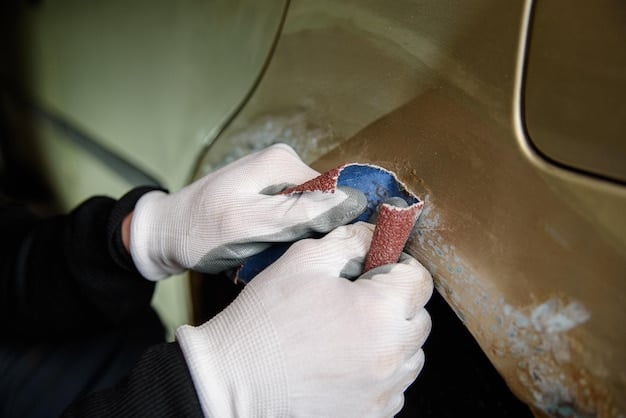
Identifying Early Signs of Rust
Regularly inspect your car for early signs of rust. Look for small bubbles or discoloration in the paint, especially in areas prone to moisture and damage. Common spots include:
- Wheel Arches: The edges and inner surfaces of wheel arches.
- Door Bottoms: The lower edges of doors, where moisture can accumulate.
- Rocker Panels: The area between the wheels, along the bottom of the car.
- Around Trim and Emblems: Areas where trim pieces are attached, as they can trap moisture.
Catching rust early makes the repair process much simpler and more cost-effective.
DIY Rust Removal
For minor surface rust, you can often tackle the problem yourself:
- Sanding: Use fine-grit sandpaper to gently remove the rust, being careful not to damage the surrounding paint.
- Cleaning: Clean the area with a solvent to remove any residue.
- Rust Converter: Apply a rust converter product, which chemically transforms the rust into a stable compound.
- Priming and Painting: Apply a primer and then touch-up paint to match the car’s color.
By following these steps, you can effectively address minor rust spots and prevent them from spreading.
When to Seek Professional Help
For larger or more severe rust issues, it’s best to seek professional help. Body shops have the tools and expertise to handle extensive rust repair, ensuring a long-lasting solution.
Promptly addressing rust spots, whether through DIY methods or professional repair, is a vital part of rust prevention. Don’t let minor issues turn into major problems.
In summary, early detection and quick action are key to managing rust. Tackle minor spots promptly and seek professional help for more significant issues.
Undercoating: An Additional Layer of Protection
Undercoating is an additional layer of protection applied to the undercarriage of your car. It can provide enhanced defense against rust and corrosion, especially in harsh environments.
Types of Undercoating
Several types of undercoating are available, each with its own benefits and drawbacks:
- Rubberized Undercoating: This provides a flexible barrier that resists chipping and cracking.
- Asphalt-Based Undercoating: This is a more durable option that offers excellent protection against moisture and impact.
- Polyurethane Undercoating: This is a tough, long-lasting option that provides superior protection against rust and corrosion.
Choosing the right type of undercoating depends on your specific needs and driving conditions. Consider factors like climate, road conditions, and budget.
Professional vs. DIY Application
Undercoating can be applied professionally or as a DIY project. Professional application ensures thorough coverage and proper adhesion, while DIY application can save money but requires more effort and attention to detail.
Whether you choose professional or DIY application, proper preparation is crucial. The undercarriage must be clean and dry before applying the undercoating. Follow the manufacturer’s instructions carefully for best results.
Benefits and Drawbacks
Undercoating offers several benefits, including:
- Rust Prevention: It provides a barrier against moisture, salt, and other corrosive elements.
- Sound Dampening: It can reduce road noise and vibrations.
- Protection Against Impact: It can protect the undercarriage from damage caused by rocks and debris.
However, undercoating also has some potential drawbacks:
- Cost: Professional application can be expensive.
- Potential for Trapped Moisture: If applied improperly, it can trap moisture and accelerate rust.
- Maintenance: Undercoating may require periodic inspection and touch-ups.
Despite these drawbacks, undercoating can be a valuable addition to your rust prevention strategy, especially if you live in an area with harsh winters or drive on unpaved roads.
In summary, undercoating offers an extra layer of protection for your car’s undercarriage. Weigh the benefits and drawbacks carefully before deciding whether it’s right for you.
Interior Protection: Preventing Rust from the Inside Out
While we often focus on exterior rust prevention, it’s important to remember that rust can also start from the inside out. Moisture and spills inside your car can lead to corrosion, especially in the floorboards and other hidden areas.
Keeping Your Interior Dry
Moisture is a major contributor to interior rust. Here are some tips for keeping your car’s interior dry:
- Address Leaks Promptly: Fix any leaks in the roof, windows, or door seals to prevent water from entering the car.
- Use Floor Mats: Floor mats protect the carpeting from spills and moisture, preventing them from reaching the metal floorboards.
- Ventilate the Car: Open windows or use the air conditioning to circulate air and reduce humidity.
Dealing with Spills and Moisture
Accidents happen, and spills are inevitable. Here’s how to deal with them effectively:
- Act Quickly: Clean up spills as soon as possible to prevent them from soaking into the carpeting.
- Absorb Moisture: Use towels or a wet vacuum to remove as much liquid as possible.
- Deodorize: Use a carpet cleaner or deodorizer to eliminate odors and prevent mold growth.
Regular Interior Cleaning
Regularly cleaning your car’s interior helps prevent the buildup of moisture and contaminants. Vacuum the carpets and upholstery, and wipe down surfaces with a damp cloth. This will help keep your car’s interior fresh and prevent rust formation.
By paying attention to interior protection, you can prevent rust from developing from the inside out. Keeping your car dry and clean is essential for long-term rust prevention.
In conclusion, interior protection is an often-overlooked but important aspect of rust prevention. By keeping your car dry and clean, you can prevent rust from forming inside.
| Key Point | Brief Description |
|---|---|
| 💧 Regular Washing | Remove salt and grime frequently, especially in winter. |
| 🛡️ Protective Barriers | Apply wax or sealant to shield paint from environmental damage. |
| 🛠️ Early Repair | Address rust spots promptly to prevent spreading. |
| 🚧 Undercoating | Consider undercoating for enhanced undercarriage protection. |
Frequently Asked Questions
▼
Wash your car at least every two weeks, increasing frequency during winter when road salt is prevalent to minimize its corrosive effects.
▼
Use car-specific soaps, high-quality waxes or sealants, and rust converter products for effective rust prevention and management on your vehicle.
▼
Apply undercoating or use a pressure washer to regularly clean the undercarriage, removing accumulated salt and grime that accelerate rust.
▼
Rustproofing is worthwhile, especially in regions with harsh winters, as it provides an extra layer of protection against corrosion and extends your car’s lifespan.
▼
You can remove minor surface rust yourself, but severe or extensive rust issues require professional attention to ensure a long-lasting, effective solution.
Conclusion
Rust prevention is an ongoing process that requires attention and care. By understanding the causes of rust, implementing effective cleaning and protection strategies, and addressing rust spots promptly, you can keep your car looking its best and extend its lifespan. Regular maintenance and proactive measures are key to winning the battle against rust.
